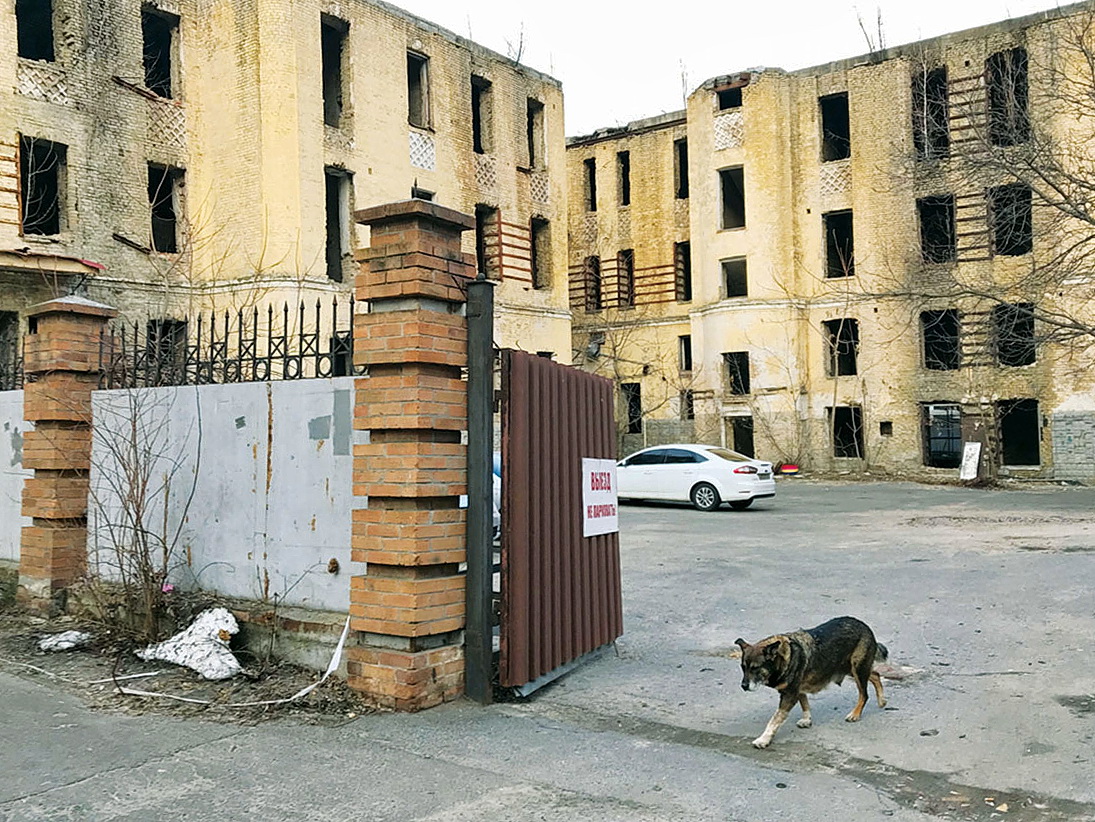Kyiv’s city center is an odd combination of modern buildings with dilapidated and abandoned historic architectural jewels.
A good example is one of the busiest streets of the capital — Velyka Vasylkivska Street.
Part of a historical building collapsed on this street 15 years ago. This was the house where Jewish writer Sholem Aleichem used to live in the beginning of the 20th century. Six years later, the building was unexpectedly demolished along with a neighboring house.
Since then the place stands empty covered with a fence at Velyka Vasilkivska 35–37.
Kyiv Zhytlo Invest Management, the former owner of the plot, planned to build there a Rezidor hotel with an underground parking and that was supposed to open right before the UEFA Euro 2012 Football Championship.
The construction, however, never happened, and in the fall of 2018, according to Interfax news agency, it was sold to TAS Group, owned by Sergiy Tigipko, a former politician and once an ally of former President Viktor Yanukovych who was ousted during the 2014 EuroMaidan Revolution.
Tas Group did not respond to the Kyiv Post before going to print regarding the future plans of the central 0.44-hectare land plot.
Just one block down at Velyka Vasilkivska 50, another house stands empty. This building has been burnt and is gradually falling apart for more than a decade.
It was built in 1909 and perfectly represented Kyiv’s modernism architecture, according to Olena Mokrousova, a historian and leading specialist on historic buildings in Kyiv and how to properly protect and restore them.
But the owners of such buildings often don’t want to take care of the city’s historical heritage as they find much more lucrative deals in other options.
“Historical buildings can be restored, but no one cares,” Mokrousova said. “All abandoned houses we have in Kyiv stand empty for decades, deliberately brought to such conditions by their owners.”

Hit by fire in 2003, the century-old building at 50 Velyka Vasylkivska is gradually falling apart. Historian Olena Mokrousova says prominent Kyiv architect Joseph Zekzer designed the house. (Kostyantyn Chernichkin)
Kyiv’s chronic pain
The empty buildings on Velyka Vasylkivska Street are not an exception in Kyiv, but rather the rule of what goes on with the city’s historical buildings: the owners will wait until the building falls apart, will then remove it from having a city protection status, and will then finally demolish it. Afterwards, they will build a new building such as an office building or a hotel.
While Kyiv is extremely rich with historical architecture, only 19 percent, or 2,237 objects, are officially registered as historic sites, according to Kyivske Viche, an advocacy group. The group’s coordinating board member, Olena Terestchenko, says that many of these buildings will be destroyed in the near future.
“The country’s priority is money, enrichment, and businesses lobby in the government both at the national and local levels,” Terestchenko said.
“Owners remove this status using any tools they have — they will set up buildings on fire or just crush them to convince the public that the house lost value,” Terestchenko said. “Once the historic status is removed, owners are not responsible for the crime and they demolish the object.”
Irina Karmanova, an activist at the No Corruption Platform, repeatedly raised the issue of empty historic buildings across Kyiv, but finds it difficult to make a difference.
“Sometimes it is possible to find out who is the owner, but this does not change anything —buildings are destroyed to make room for new buildings,” said Karmanova.
But another reason why owners are reluctant to keep historic buildings is the high renovation cost to maintain a historic building, and the government does little in financial assistance.
But it’s expensive not only in Ukraine, it’s expensive everywhere, Mokrousova said.
“This is the consciousness of society. People will need to realize that this antiquity is worth more than just money… In the U.K., you can’t even change an old window locking system.”
She says that Kyiv is different simply because owners tend to be greedy.
“Owners that have close ties with the authorities receive historical buildings for nothing and simply have no interest in restoring them,” said Terestchenko.
At the same time, Roman Kostenko, a real estate lawyer at Asters, says that there are other reasons of why so many historic buildings are not being taken care of.
Very often, according to Kostenko, there is a legal problem — the building can either be arrested, there can be a conflict between owners, or the object is state-owned. In either case, the city has no mechanism on how to deal with the problem.
At other times, an owner will buy assets and wait for the best market conditions so that the property can be resold at a much higher price.
Historic street
Built in the beginning of the 19th century, Velyka Vasylkivska Street starts from Khreshchatyk Street and cuts through three districts — Shevchenko, Perchersk and Holosiyiv — making it one of the longest streets in Kyiv.
According to Mokrousova, many famous individuals lived on this street a century ago such as writer Isaac Babel, merchant David Margolin, as well as nobleman Petro Krutikov, the owner of a world-renowned circus.
During the Soviet era the street was called Chervonoarmiyska, or Red Army. The original name was returned only in 2014, the same year when Russia started its war against Ukraine.
But experts like Mokrousova believe that the history of such streets as Velyka Vasilkivska will fade away very soon.
“(Ukraine) is a country where nothing can be changed. By law, nothing can be destroyed,” said Mokrousova. “But does the law work in our country?”

Velyka Vasylkivska Street is one of the Kyiv’s busiest streets and yet many of its buildings stand empty and dilapidated. (Pavlo Podufalov)
